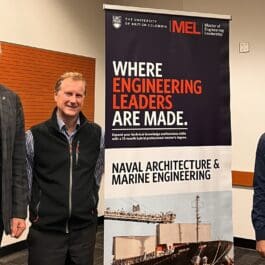Naval Architecture and Marine Engineering — Sohan Mishra
Alumnus Story - Sohan Mishra

Having worked in the maritime industry both at sea and ashore, Sohan Mishra has a holistic perspective on the fast-evolving marine industry through his experience in vessel performance and project management.
After obtaining a degree in marine engineering, Sohan Mishra launched a successful career as a marine engineer, working on dry bulk and ultra-large container carriers for global ship-owning companies for more than four years.
“Life at sea is completely different from the side of shipping you see in an office,” he says. “I was inquisitive and wanted to learn more about the commercial aspects of shipping – to bridge that gap between the technical and commercial parts of the business.”
This desire to understand the commercial side of the marine industry spurred him to complete a two-year MBA in shipping and port operations, following which he worked on vessel performance and the energy-efficiency side of vessel operations.
“When I stepped from sailing to the shore side of commercial operations, I could clearly see there is a long way to go to optimize and improve the environmental aspects of vessel performance,” he says.
Always interested in expanding his knowledge base, Sohan learned about UBC’s Master of Engineering Leadership (MEL) in Naval Architecture and Marine Engineering and saw it as a path to gain an even broader understanding of naval architecture, ship building and marine operations.
“The MEL was a perfect fit for me because half of the curriculum is related to the business side of operations, with the other half focusing on pure naval architecture and marine engineering.”
Engineering courses offer a holistic view of the maritime industry
Students take engineering courses that cover the entire shipbuilding life cycle – from initial design requirements and vessel construction to operations, maintenance and eventual retirement.
“The naval architecture and ship design courses balanced each other perfectly,” he says.
“The shipbuilding courses focused on the commercial aspects of making a business plan work, while the ship design courses dove into the intricacies of real-world decisions in building a vessel from scratch. The two aspects come together to create a design spiral helping us understand many different perspectives when it comes to purchasing or building a new vessel or completing a retrofit on an existing vessel.”
One highlight was working on group projects with his fellow colleagues who came to the program with a diverse range of industry experience – from sailing on submarines to shipbuilding and shipyards experience, and from both the seafaring side and the commercial side.
“All these experiences came together as we generated ideas for our projects, which is not always possible when you are just working with the same kinds of people from the same professional backgrounds.”
In the summer, students in the Naval Architecture and Marine Engineering program complete either a research project or an internship. Sohan landed a summer position with Fednav Limited, Canada’s largest bulk shipping company. He moved to Montreal for three months to create a hull performance dashboard for the entire fleet, working on energy-efficiency aspects of vessel performance management.
“We created a dashboard for the Fednav fleet and brought in some underwater inspection tools that could be controlled by robotics to remove invasive species from the hull,” he explains.
Business courses develop engineering leadership skills
In addition to the technical engineering courses, students take business and leadership courses offered through UBC Sauder’s Robert H. Lee Graduate School that explore organizational leadership, strategy and innovation, and sustainability and leadership.
Although Sohan already had an MBA, he says that the business courses that are part of MEL pushed him to think about leadership and sustainability in new ways.
“For me, an engineer is someone who gets into the technical side and wants to make the changes that will bring new efficiencies to a project. An engineering leader has that technical knowledge, but is also able to connect that to the business environment and strategy. It’s sort of a techno-commercial approach that I believe can be learned. This program helps you learn how to have confidence in your ideas so you can get the backing of a wide range of stakeholders, from technical managers to company owners and financial institutions.”
Hired before graduation
Before he graduated, Sohan began working full time for Albion Marine Solutions as a business development manager in the Global Commercial Team. Albion is a technical services solutions provider in the marine sector that works on projects encompassing energy efficiency, safety management, and working with ship owners and vessel managers to provide vessel inspections and innovative solutions. Sohan juggles four to five projects at a time, collaborating with industry partners to work on sustainable shipping projects within the global maritime industry.
“The MEL has given me a year to upgrade my skill set in line with new trends, regulations and requirements within the industry,” he says. “Having that Canadian education and work experience, with a desire to learn and grow, helped me adapt fast in Canada.”
Sohan has advice for people considering a program like the MEL.
“Do your research. Be very sure about what your passion is, and then build a network around that subject of interest. Believe and the world will believe in you!”
–
Take the steps to join the next cohort of engineering leaders. If you haven’t already, assess your eligibility and sign up for the upcoming information session to learn how to submit a strong application. Learn more about this innovative master’s program:
Application Deadlines
The online application portal for the January 2025 has closed.
Get ready to apply!
Admissions for the 2026 intake will open on January 1, 2025.
How to ApplyJoin us for an
Info Session
Sign up for our latest online information sessions and discover what our programs have to offer.
Sign Up NowAssess your Eligibility
Determine if your professional experience and academic background make you a fit for your desired program.
Start AssessmentApplicant Guide
Navigate the application process with ease!
Sign up to receive tailored instructions and a detailed guide directly to your email.
Sign upFeatured Alumni

Clifford Mascarenhas
The MEL in Naval Architecture and Marine Engineering enabled Clifford Mascarenhas to expand his technical knowledge and business skills – providing a foundation for the next chapter in his career: working in Vancouver’s shipyards as part of Canada’s shipbuilding industry.
Featured Faculty and Staff

JON MIKKELSEN
"Students in the MEL in Naval Architecture and Marine Engineering program will have many opportunities to work on technical engineering projects alongside industry partners."
Naval Architecture and Marine Engineering
Combine the engineering and physics of ship design with broad business and leadership training.
Read More

